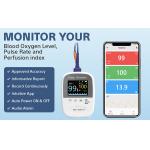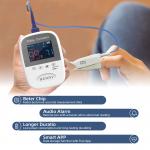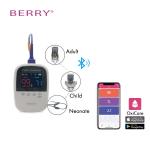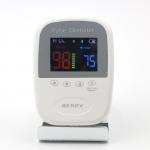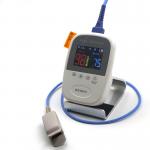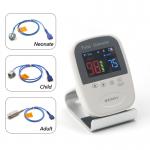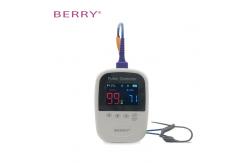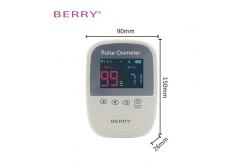Indicator buzzer PR Handheld Pulse Oximeter
Introduction
The original oximeter was developed by Millikan in the 1940s. It
monitors the ratio of oxygen-carrying hemoglobin to oxygen-free
hemoglobin in arteries. A typical oximeter has two LEDs. The two
LEDs face the part of the patient to be tested - usually the
fingertip or earlobe. One diode emits a beam with a wavelength of
660 nanometers and the other emits 905, 910 or 940 nanometers.
Oxygenated hemoglobin absorbs these two wavelengths very
differently than without oxygen. Using this property, the ratio of
the two hemoglobins can be calculated. The procedure for the test
usually does not require blood to be drawn from the patient. A
normal oximeter can also display the patient's pulse. According to
the Beer-Lambert law, the functional relationship between the ratio
R/IR and arterial oxygen saturation (SaO2) should be linear, but
because biological tissue is a complex optical system with strong
scattering, weak absorption, and anisotropy [2- 4], which does not
fully comply with the classical Beer-Lambert law, thus leading to
the establishment of a mathematical model expressing the
relationship between the measured value of the relative change in
the absorbance of red and infrared light (R/IR value) and the
arterial oxygen saturation (SaO2). difficulty. The corresponding
relationship between R/IR and SaO2, that is, the calibration curve,
can only be determined experimentally. Most pulse oximeter
manufacturers use experimental methods to obtain empirical
calibration curves to complete the pre-calibration of the products
before leaving the factory.
| Pi indicator | Buzzer indicator |
| Battery status | Pulse rate indicating |
| Pulse rate | Pulse rate bar graph |
| Menu | Button down |
Features
People with vascular diseases (coronary heart disease,
hypertension, hyperlipidemia, cerebral thrombosis...) have lipid
deposition in the vascular cavity, poor blood flow, and difficulty
in oxygen supply. Cardiovascular and cerebrovascular patients,
blood viscosity, plus coronary Sclerosis, narrowing of the vascular
lumen, resulting in poor blood supply and difficulty in supplying
oxygen. Every day the body…
Factory
Industrial automation is an important prerequisite for starting
Industry 4.0, BERRY as the industry leader,is keeping pace with the
trend of the times.we have been implementing automation on our core
technology and became the creator of advanced manufacture
technology in the industry.
Why Choose Us
Shanghai Berry Electronic Tech Co., Ltd. is located in Shanghai
Caohejing High-tech Park, a beautiful low-carbon and
environmentally friendly city. We have been devoted to the R&D,
manufacturing and sales of medical electronic instruments in the
field of monitoring since 2003.
Our Bio-Medical technology has reached the domestic advanced level.
Important breakthroughs have been made in non-invasive blood
pressure calculation methods, blood oxygen saturation detection,
and multi-parameter monitoring systems. After years of development,
we have established good cooperative relations with customers
worldwide, with annual sales reaching tens of millions dollars.
BERRY always provides customers with high-quality, cost-effective
products. It is important for us to maintain good quality.
In 2009, we obtained the production license and product
registration certificate that issued by Shanghai.
ln 2014, we passed the EN ISO 13485 quality system certification
and CE0123 certification by TÜV SÜD. And we got the 510K for the
wrist and handheld pulse oximeter
ln 2015, we got ANVISA, INMETRO Approved.
In 2016, we got FDA510K approved for fingertip pulse oximeter.
In 2018, we got CE0123 approved for Patient Monitor and new watch
oximeter
In 2019, we established Shenzhen factory.
In 2022-now, our business growing up rapidly, and have more
cooperation partners.
